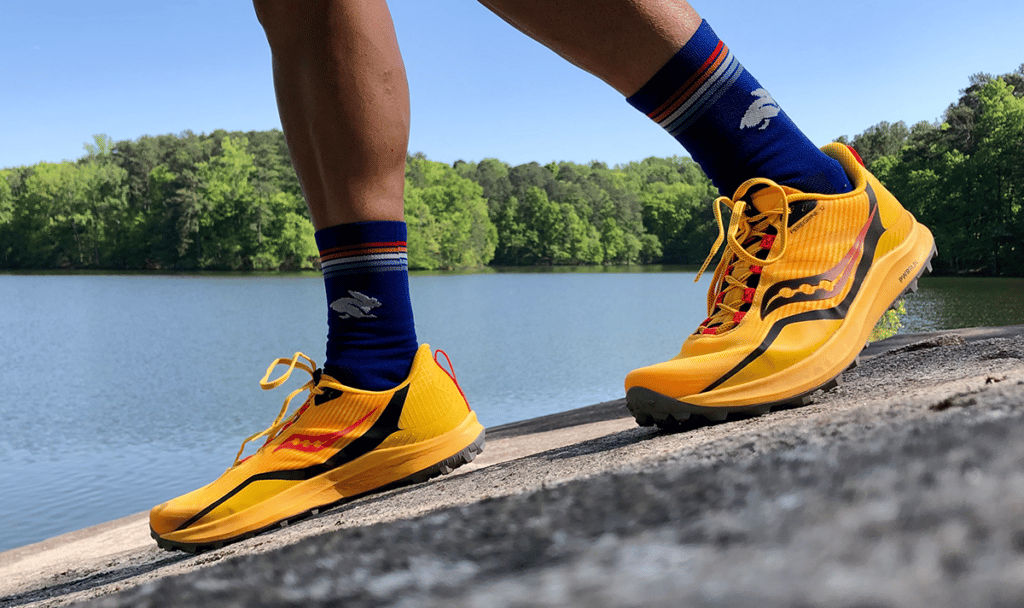I got my hands on the Saucony Peregrine 12 and have logged over 100 miles over the last few months and can now provide a full review. Is this a trail shoe you should consider? Keep reading to learn more!
by Dave Martinez

With so many new models of trail shoes with higher stack heights, it might be easy to overlook the Saucony Peregrine 12. I think the last time I ran in a Peregrine was version 4 or 5. I’ve definitely gravitated more toward the higher stack height shoes like those from Hoka. One of my favorites for ultra distances has been the Hoka Speedgoat. So I was curious whether I would miss the extra cushioning.
Saucony Peregrine 12 Specs
The Saucony Peregrine 12 lost over an ounce from the previous version. As runners, we’re always wanting a lighter version but that doesn’t always translate to a better shoe. In this case, while I can’t say it’s a better shoe than the previous one (since I didn’t try it or have to compare), it does make running a bit more fun as it makes for a faster feeling experience. The Peregrine 12 has a 4mm drop and a forefoot height of 22.5mm and a rear height of 26.5mm, it’s the lowest stack height in their entire trail shoe lineup. For comparison, the Hoka Speedgoat has 34mm/38mm stack heights. These shoes are on opposite ends of the trail shoe spectrum and will offer a completely different experience. The only spec shared by both of these shoes is the 5mm lugs that offer great traction.
Fit
I had no issues with the fit. The Saucony Peregrine 12’s upper fits me pretty well once laced up. The toe box isn’t overly generous but I didn’t have any issues with hotspots or rubbing. It has a fully gusseted tongue so it doesn’t move and prevents any debris from getting into the shoe through the laces. Speaking of the laces, the upper doesn’t have the traditional eyelets. Instead, the laces go through these straps that help cinch the upper so it feels snug on the foot. After 100 miles the upper is holding up nicely. With heat-welded overlays to protect the areas around the forefoot including the toes, there’s no sign of wear. The minimal and I would say seamless upper help reduce the weight with no points to irritate the foot.
Feel
There’s minimal padding around the heel or even the tongue. So it feels good and it feels light. The upper is also very breathable and drains water really well. I did a few stream crossings submerging my foot about halfway up the shoe and within a few miles, my foot felt dry. The PWRTRAC outsole has a very grippy feel in just about all conditions. The 5mm lugs also provided a lot of traction in loose dirt or muddy conditions. Of course, on wet smooth rocks like granite, foot placement is important because no matter the shoe, there’s always a chance of losing grip.
Ride
The Saucony Peregrine 12 is a lightweight shoe and you feel it …and that’s a good thing. Leg turnover was never an issue and I always felt fast on my runs. I think I set a few PRs on some segments in my many loops around Stone Mountain. The PWRRUN midsole is not the softest but it’s not firm either. There’s just enough cushion to absorb the impact and not slow you down. It’s also a very flexible shoe which helps it adapt to the terrain so much better. While a max cushion shoe feels softer, it’s also quite a bit stiffer. I think a stiff shoe can keep your foot from adapting to the terrain and affect your proprioception.
Conclusion: Saucony Peregrine 12
So is the Saucony Peregrine 12 a shoe for you? That depends on the runner and trail experience you prefer. The fit should accommodate most people unless you normally need a wide shoe (a wide version is also available). If you do short trail runs (6-8 miles) and prefer something lightweight that will tear up the trail, this is a great option. I do think you can go longer distances. I’ve gone as much as 12 miles and plan on running as much as 19 miles in an upcoming race. I will need to take some time building up to that distance and make sure my feet are acclimated to the shoe over longer distances. If you prefer slower runs and a softer platform, a trail shoe with a higher stack height might be a better option. Of course, we recommend you visit one of our locations and try them on for yourself. If this review was enough to convince you to purchase, we also have them available online with free shipping.



